NCERT Solutions for Class 5 Maths Chapter 10 Tenths and Hundredths offer comprehensive and detailed explanations for the concepts covered in this chapter. These solutions are designed to assist students in understanding the topics related to tenths and hundredths with clarity and precision. NCERT Solutions for Class 5 Maths Chapter 10 Tenths and Hundredths provide step-by-step solutions to numerical problems, ensuring that students can grasp the underlying principles and apply them effectively. By referring to these solutions, students can enhance their mathematical skills and develop a solid foundation in decimal fractions.
NCERT Solutions for Class 5 Maths Chapter 10 are prepared by experienced educators who have a deep understanding of the curriculum and the needs of students. These solutions are accessible and serve as an invaluable resource for self-study and revision. With the help of NCERT Solutions for Class 5 Maths Chapter 10, students can gain confidence in dealing with decimal fractions and excel in their examinations.
NCERT Solutions for Class 5 Maths Chapter 10 Tenths and Hundredths has been published by exammodalpaper. You can now download the NCERT Solutions for Class 5 Maths Chapter 10 Tenths and Hundredths Questions and Answers PDF here. This NCERT Solutions for Class 5 Maths contains answers of all questions asked in Chapter 8 in textbook. Therefore you can prerefer it to solve Be My Multiple, I’ll be Your Factor exercise questions and learn more about the topic.In lesson 10 of Class 5 Maths, students learn .
NCERT Solutions for class 5 Maths Chapter 10 Tenths and Hundredths
Question 1: a) What was the length of the smallest pencil you have used?
b) How long is this pencil? Guess___ cm 
c) Measure it using a scale. How good is your guess?
Answer : a) Do it by yourself. Answers may vary. The length of the smallest pencil I have used is 2 cm.
b) Guess on your own and answer the question. I guess the pencil is 3 cm long.
c) I guess it is 3.5 cm long. On measuring, it turned out to be 3.6 cm long. So, I made a good guess.
Question 2: a) What is the length of this pencil? __mm.
b) What is the length of this pencil in centimetres?

Answer: a) The length of the pencil is 6 mm.
b) The length of the pencil is 0.6 cm.
Frogs
Question 1: a) What does 0.9 cm mean? It is the same as __ millimetres.
b) We can also say this is nine-tenths of a cm. Right?
c) So, 30.5 cm is the same as __ cm and __ millimetre.
d) About how many of the big frogs will fit on the 1 m scale? ___
e) If they sit in a straight line about how many of the small frogs will cover 1 m? ___
Answer: a) The relation between cm and mm is: 0.1 cm = 1 mm
b) 1 mm is one-tenth of a cm. So, we can say 9 mm is nine-tenth of a cm.
c) 30.5 cm is the same as 30 cm and 5 mm.
d) The relation between m and cm is: 1 m = 100 cm Since 1 big frog is 30.5 cm long, about 3 big frogs will fit on the 1 m scale.
e) Since 1 small frog is 0.9 cm long, about 111 small frogs will cover 1 m.
Practice Time
Question 1 :

Length of the nail — 2 cm and __ mm or 2. __ cm.
Answer: Length of the nail – 2 cm and 9 mm or 2.9 cm.
Question 2:

The length of this lady’s finger (bhindi) is __ cm and __ mm. We can also write it as __ cm.
Answer: The length of this lady finger (bhindi) is 8 cm and 3 mm. We can also write it as 8.3 cm.
3. Using the scale on this page, find the difference in length between candle 1 and candle 3.

Answer-

1. Which line is longer? A or B? Measure each line and write how long it is in centimetres. How good is your guess?

Answer-
Line B is longer than line A.
Line A = 4.6 cm
Line B = 4.6 cm
2. Which line is longer? C or D? Measure each line. How good is your guess?

Answer-
Line C is longer than line D.
By measuring both, the lines are equal.
C = D = 3.2 cm
Whose Tail is the Longest?
1. Guess whose tail is the longest. Now, measure the tails. How good is your guess?

Answer-
From the figure, we know that the monkey’s tail is the longest. The measurement of tails is given below.
![]()
The Longest Rupee Notes?
1.What is the length of a 100 rupee note? Guess.
Now measure it using a scale.
Ans. I guess that the 100 rupee note is 16 cm long. On measuring I found it 15.5 cm long.
2.Now guess the length and width of many other things. Measure and find the difference between your measure and your guess.
Ans.
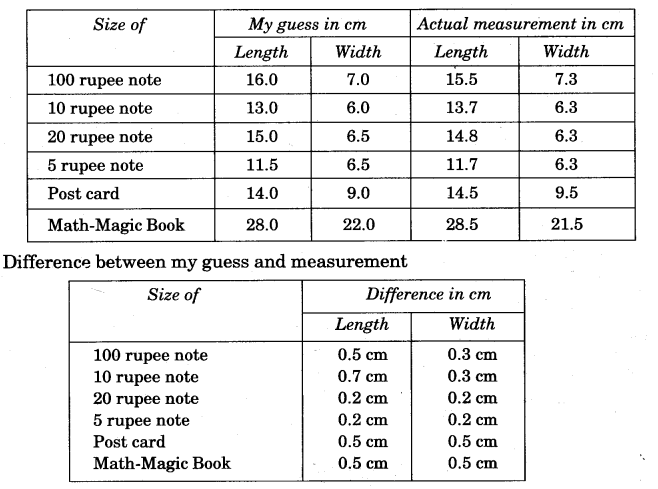
At the Market
1.How many paise does a matchbox cost?
Ans. 50 paise.
2.How many matchboxes can be got for Rs 2.50?
Ans. Five.
3.How many rupees does the soap cost?
Ans. 8.75
4.Arun wanted to buy a soap. He has a five-rupee coin, 2 one-rupee coins and 4 half-rupee coins. Write in rupees what money he will get back?
Answer: Arun has:
1 five-rupee coin = Rs 5
2 one-rupee coins = Rs 2
4 half-rupee coins = Rs 2
Total amount = 5 + 2 + 2 = Rs 9
Since the cost of a soap is Rs 8.75, he will get back
9 – 8.75 = Rs 0.25.
Question 5: a) An egg costs two and a half rupees. How much will one and a half dozen cost?
b) How many pens can Kannan buy? How much money is left?

Answer: a)Cost of an egg = Rs 2.50
One and a half dozen eggs = 12 + 6 = 18 eggs Cost of 18 eggs = 18 x 2.50
= 18 x 2 + 18 x 0.50 = 36 + 9 = Rs45
Money left = Rs60 — Rs45 = Rs15
Answer: b)Yes, she can buy two pens with Rs 13.
Question 1: Match each yellow box with one green and one pink box.

Answer: Match the rupee with equivalent paise, and the rupee written in decimals. The correct answer is:

Question 2: a) What part of this sheet is coloured blue?__/10
b) What part of the sheet is green? __
c) Which colour covers 0.2 of the sheet?

Answer: The sheet can be divided into 10 long strips. So, each long strip is 1/10 or 0.1 of the sheet.
a) 1/10 part of this sheet is coloured blue..
b) 3/10 part of the sheet is green..
c) Yellow colour covers 0.2 of the sheet
Question 3: a) Look at the second sheet. Each strip is divided into 10 equal boxes. How many boxes are there in all?

b) Is each box 1/100 part of the sheet? How many blue boxes are there? __ Is blue equal to 10/100 of the sheet? We saw that blue is also equal to 1/10 of the sheet. We wrote it as 0.1 of the sheet. Can we say 10/100 = 1/10 = 0.10 = 0.1?
c) Can we write ten paise as 0.1 of a rupee?
d) How many boxes are red? What part of the sheet is this? 15/__ Can we also write it as 0.15 of the sheet?
e) Now 3/100 of the sheet is black. We can say 0.__ sheet is black.
f) How many white boxes are there in the sheet? What part of the second sheet is white? ___
Answer: a) There are 10 × 10 = 100 boxes in all.
b) Since there are 100 equal boxes, each box is 1/100 of the sheet.
There are 10 blue boxes. So, the blue portion is 10/100 of the sheet.
10/ 100 = 1/10 = 0.10 = 0.1
c) There are 100 paise in one rupee. Therefore,
10 paise = 10/100 rupee = 1/10 rupee = 0.10 rupee = 0.1 rupee
d) There are 15 red boxes. Since the sheet is divided into 100 equal boxes, the red colour is 15/100 of the sheet.
15/100 = 0.15
So, the red colour is 0.15 of the sheet.
e) 3/100 of the sheet is black.
3/100 = 0.30
Therefore, 0.30 of the sheet is black.
f) There are 22 white boxes on the sheet. 22/100 part of the second sheet is white.
Make your designs.
Make a nice design by colouring 0.45 part of this square red.
Ans.
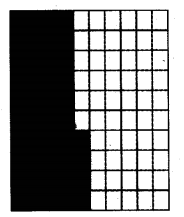
13.Use four colours. Each colour should cover 0.05 of this square.
Ans.
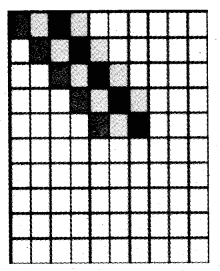
Sports Day
The school at Malappuram has its sports day.
The first five children in the Long Jump are:
Teena: 3.50 m Meena: 4.05 m Rehana: 4.50 m Anu: 3.05 m Amina: 3.35 m
Teena jumped 3.50 m which is 3 m and 50 cm.

1.But how far did Anu jump?————— m and—————cm
Ans. 3 m and 5 cm.
2.Who is the winner in the long jump?
Ans. Rehana.
3.Write the names of the I, II and III winners on this stand.
Ans.First: Rehana
Second: Meena
Third: Teena
Do you remember that 1 metre = 100 centimetre? So one centimetre is 1/100 of a metre.
We also write 1 cm as 0.01m

Write in Metres
3 metre 45 centimetre = 3.45m
99 centimetre = 0.99m
1 metre and 5 centimetre = 1.05m
(a)How Big Can You Get
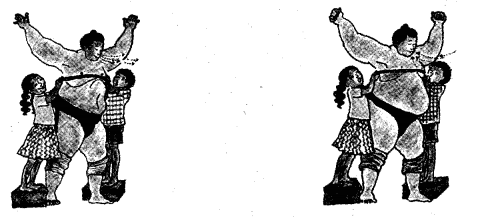
After breathing out 1.52 m On taking a deep breath 1.82 m Difference in size = 1.82 – 1.52 = 0.30 m Do this for yourself and find the difference.
(b)What is Dinesh’s height in metres?
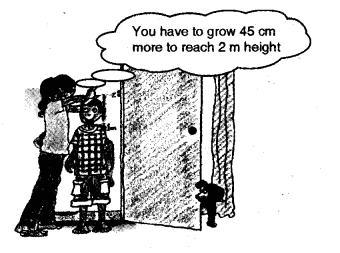
……………….m………………….
Ans.2m-45m
=200cm-45cm=155cm
=1m 55cm
Practice time
Money from different countries
1.Have you seen any notes or coins used in any other country?
Ans. Yes, I have seen the notes and coins of the United Kingdom.
2.Shivam Bank has a chart to show us how many Indian rupees we can get when we change the money of different countries.
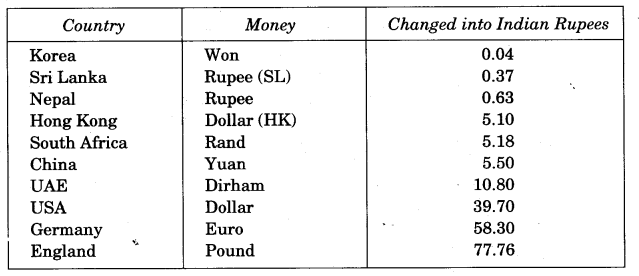
(This is the rate on 15-2-2008)
(a)The money of which country will cost the most in Indian Rupees?
Ans. The money of England will cost the most in Indian Rupees.
(b)Mithun’s uncle in America had sent him 10 USA dollars as a gift. Mithun used 350 rupees for a school trip. How much money was left with him?
Ans. Money received by Mithun = 10 USA Dollar 1 USA Dollar = 39.70
Hence, money received by Mithun = 10 x 39.70
= 10 x 39 + 10 x 0.70 = 390 + 7 = 397 rupees
Money spent on school trip = Rs350
Money left with him = Rs397 — Rs350 = Rs47
(c)Majeed’s father is working in Saudi Arabia. He gets 1000 Saudi Riyal as salary. Arun’s father who is working in Sri Lanka gets 2000 Sri Lankan Rupees. Who gets more Indian Rupees as salary?
Ans. Majeed’s Father’s salary = 1000 Saudi Riyal
= 1000 x ? 10.52 = 1000 x 10 + 1000 x 0.52
= 10000 + 520 = 10520 Rupees
Arun’s father’s salary = 2000 Sri Lankan Rupees
= 2000 x Rs0.37 = 2000 x 37 paise = 74000 paise
= 740 Rupees
Hence, Majeed’s father gets more Indian rupees.
(d)Leena’s aunty brought a present for her from China. It cost 30 Yuan. Find what it costs in Indian rupees.
Ans. 1 Yuan = Rs 5.50
So, 30 Yuan = 30 x 5.50
= 30 x 5 + 30 x 0.50 = 150 + 15 = 165 Rupees
(e)Astha wants some Hong Kong Dollars and Won.
(i)How many Won can she change for Rs 4? For Rs 400?
(ii)How many Hong Kong Dollars can she change for Rs 508?
Ans. (i) 1 Won = Re. 0.04
Hence, 100 Won = 4 (Multiply on both sides by 100)
Hence, Astha gets 100 Won for Rs4
And for Rs400 she gets:
100 x 100 = 10000 Won
(ii) 1HK Dollar = Rs 5.10 Hence, Rs 508 = 508 + 5.10
= 99.61 HK Dollar
3.Kiran went shopping with Rs 200. Look at the bill. The shopkeeper forgot to put the point correctly in the prices. Put the point in the correct place and find out the total amount of the bill.
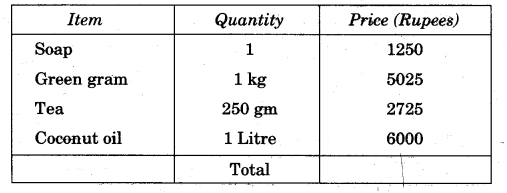
Ans. The correct bill is as follows:
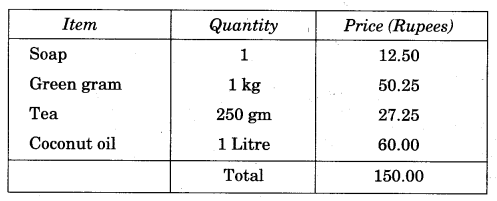
Which City Is Cool?
The temperature in each city was noted at 3 p.m. on 16 January 2008.
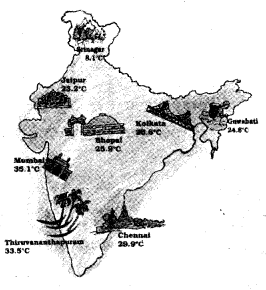
1.Which place had the highest temperature at 3 p.m.? Which place is the coolest at that time?
Ans. Mumbai had the highest temperature.
Srinagar is the coolest place at that time.
2.How much higher is the temperature in Mumbai from that in Srinagar?
Ans. (35.1-8.1)°C = 27.0°C
3.How many degrees will the temperature need to rise for it to reach 40°C in Thiruvanantha- puram?
Ans. 40°C – 33.5°C = 6.5°C
4.How much lower is tha temperature in Kolkata from that in Chennai?
Ans. 29.9°C – 26.6°C = 3.3°C
5.The temperature in these cities was also noted at 3 a m. on the same day. Look at the table and answer the questions.
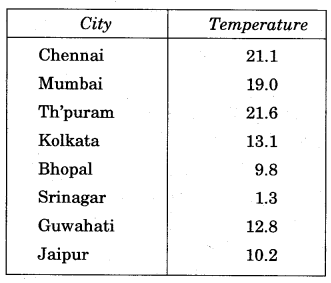
Which place had the lowest temperature at 3 a.m.? Imagine yourself to be there and describe how it would feel.
Ans. Srinagar
The temperature is 1.3°C means it is very cold and the water in pipes froze into ice. We will have to wear woolen cloths and sit near fire.
(b)What is the difference between the temperatures at 3 p.m. and 3 a.m. in Chennai? In Bhopal?
Ans. Chennai
The difference in temperature in Chennai is given below.
Temperature at 3 pm = 29.9o C
Temperature at 3 am = 21.1o C
So, the difference = 29.9 – 21.1 = 8.8o C
The difference in temperature in Bhopal is given below.
Temperature at 3 pm = 25.9o C
Temperature at 3 am = 9.8o C
So, the difference = 25.9 – 9.8 = 16.1o C
Related Post :-
Chapter 4. Parts and Wholes
Chapter 5. Does it Look the Same?
Chapter 6. Be My Multiple, I’ll be Your Factor
Chapter 7. Can You See the Pattern?
Chapter 8. Mapping Your Way
Chapter 9. Boxes and Sketches
Chapter 10. Tenths and Hundredths
Chapter 11. Area and its Boundary
Chapter 12. Smart Charts
Chapter 13. Ways to Multiply and Divide
Chapter 14. How Big? How Heavy?
NCERT Solutions Class 5 to 10
- NCERT Solutions for class 5 Maths
- NCERT Solutions for class 5 EVS
- NCERT Solutions for class 5 Paryayana Adyayan
- NCERT Solutions for class 5 English
- NCERT Solutions for class 5 Hindi
Frequently Asked Questions For NCERT Solutions for class 5 Maths Chapter 10 Tenths and Hundredths
What are NCERT Solutions for Class 5 Maths Chapter 10 Tenths and Hundredths?
NCERT Solutions for Class 5 Maths Chapter 10 Tenths and Hundredths are comprehensive answers and explanations provided for the questions and problems present in the textbook. These solutions help students understand and solve mathematical problems related to decimal fractions.
How can NCERT Solutions for Class 5 Maths Chapter 10 Tenths and Hundredths benefit students?
NCERT Solutions for Class 5 Maths Chapter 10 Tenths and Hundredths serve as a valuable resource for students. These solutions enhance students’ understanding, improve their problem-solving skills, and boost their confidence in dealing with decimal fractions.
Are NCERT Solutions for Class 5 Maths Chapter 10 Tenths and Hundredths easy to understand?
Yes, NCERT Solutions for Class 5 Maths Chapter 10 Tenths and Hundredths are designed to be student-friendly and easy to comprehend. The solutions are written in a clear and concise manner, ensuring that students can grasp the concepts related to decimal fractions easily.
How can I access NCERT Solutions for Class 5 Maths Chapter 10 Tenths and Hundredths?
NCERT Solutions for Class 5 Maths Chapter 10 Tenths and Hundredths can be accessed through various mediums.
Can NCERT Solutions for Class 5 Maths Chapter 10 Tenths and Hundredths help in exam preparation?
Certainly! NCERT Solutions for Class 5 Maths Chapter 10 Tenths and Hundredths are an excellent resource for exam preparation. By practicing the solved examples and exercises provided in these solutions, students can familiarize themselves with the question patterns and improve their problem-solving abilities in relation to decimal fractions.
Are NCERT Solutions for Class 5 Maths Chapter 10 Tenths and Hundredths useful for self-study?
Yes, NCERT Solutions for Class 5 Maths Chapter 10 Tenths and Hundredths are highly beneficial for self-study. These solutions provide comprehensive explanations, allowing students to learn independently.
Are NCERT Solutions for Class 5 Maths Chapter 10 Tenths and Hundredths aligned with the latest curriculum?
Yes, NCERT Solutions for Class 5 Maths Chapter 10 Tenths and Hundredths are meticulously prepared in accordance with the latest curriculum prescribed by the NCERT (National Council of Educational Research and Training). These solutions cover all the topics and concepts included in the curriculum.
Can NCERT Solutions for Class 5 Maths Chapter 10 Tenths and Hundredths be used by teachers as well?
Absolutely! NCERT Solutions for Class 5 Maths Chapter 10 Tenths and Hundredths serve as a valuable tool for teachers. They can use these solutions to plan their lessons, guide classroom discussions, and assess students’ progress. The solutions provide teachers with a comprehensive reference for teaching the chapter effectively.
Are NCERT Solutions for Class 5 Maths Chapter 10 Tenths and Hundredths available for free?
Yes, NCERT Solutions for Class 5 Maths Chapter 10 Tenths and Hundredths are available for free. They can be accessed online through various educational websites and platforms. Additionally, they may also be provided by schools or teachers to their students.
Share to help
